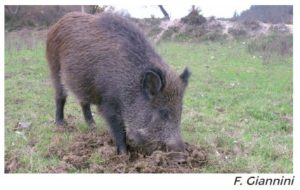 Common name: WildBoar
Common name: WildBoar
Scientific name: Sus scrofa
Brief description: The light brown coat with dark stripes of the young under one year old (precisely called “striped”), becomes reddish-brown in young individuals to then become black-dark brown in the coat of adults. Males are larger than females and can even weigh over 100kg.
Biology and ecology: The boar is able to adapt to a large number of different environments and feeds on plant or animal foods, carcasses of dead animals, birds’ eggs, and invertebrates. Its long tusks and robust snout make it an excellent digger able to make large holes and furrows in the ground while searching for bulbs, tubers and roots.
Distribution in the Tuscan Archipelago and introduction: In the Tuscan Archipelago the boar is only present on the Island of Elba where it was introduced for hunting purposes between the ‘50s and ‘60s.
Impact: Due to its great adaptability and behaviour, the boar causes considerable damage not only to the flora and fauna, but also to agricultural and residential systems, with heavy economic repercussions.
Management in protected areas: Since 1998 the boar has been subject to a withdrawal campaign within the Park, from which over 12,000 individuals have been removed.




